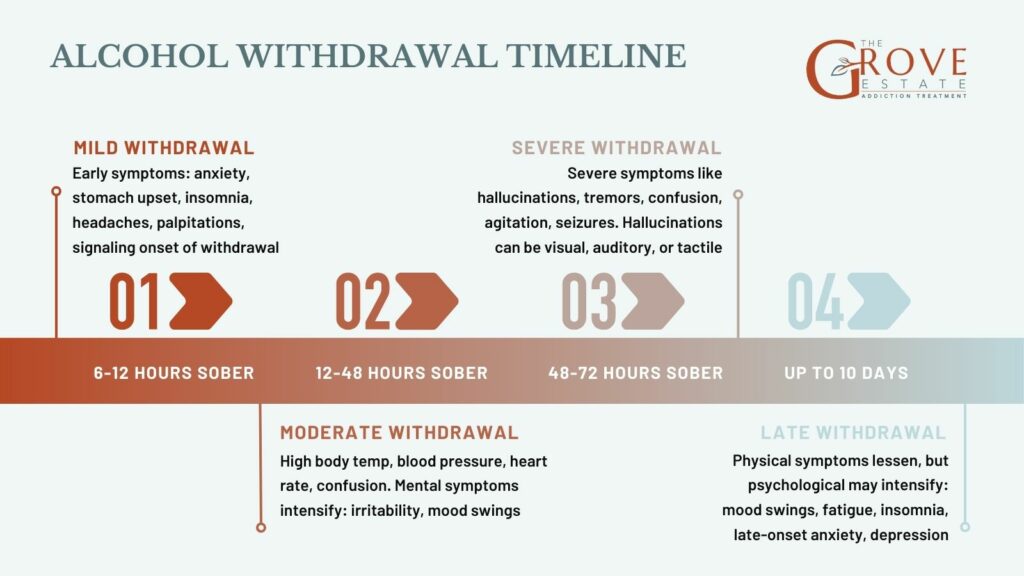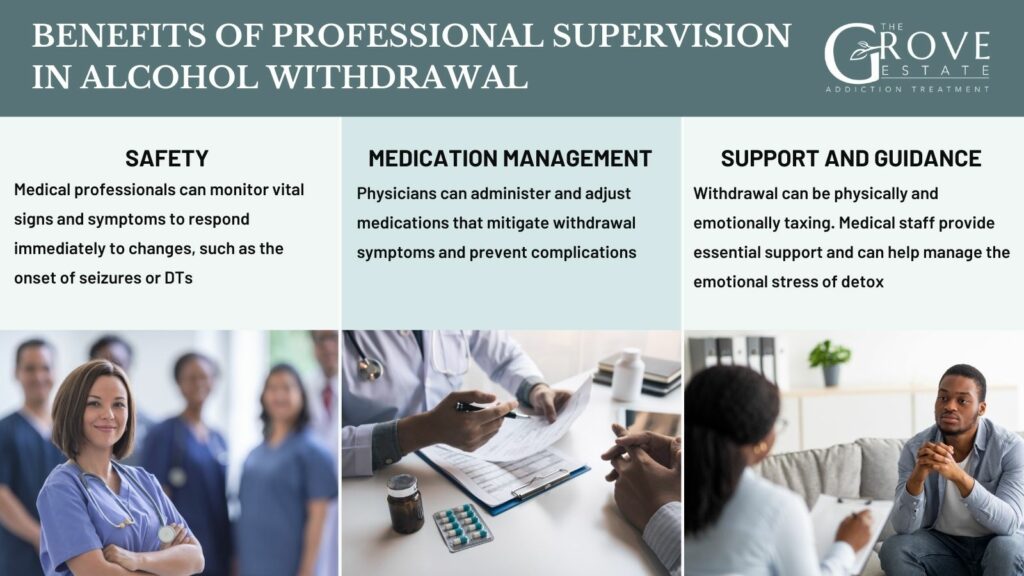Alcohol withdrawal is a significant medical condition that can occur when an individual who has been drinking excessively stops or significantly reduces their alcohol intake. According to the National Institute on Alcohol Abuse and Alcoholism (NIAAA), approximately 50% of people with alcohol use disorder will experience withdrawal symptoms upon reducing or stopping alcohol consumption.
The symptoms of alcohol withdrawal can range from mild to severe, and they typically begin within hours to a few days after the last drink. Common symptoms are anxiety, shaking, sweating while more severe cases lead to hallucinations, seizures, and delirium tremens (DTs), which are potentially life-threatening.
Treatment for alcohol withdrawal often requires medical supervision to ensure safety and effectiveness. Mild withdrawal symptoms might be managed at home with medication to reduce discomfort, while moderate to severe symptoms often require hospitalization or treatment in a specialized detox facility. Treatment for alcohol dependency may also include counseling and support groups to address underlying issues.
The prevention of alcohol withdrawal centers on managing alcohol consumption and dependency. Individuals at risk should gradually reduce alcohol intake under medical supervision, using a tapering schedule and possibly medications to safely manage withdrawal symptoms. Early education and promoting healthy lifestyle choices are crucial for long-term recovery and sobriety.
What Is Alcohol Withdrawal?
Alcohol withdrawal is a condition that arises because of prolonged and excessive alcohol use. It disrupts the central nervous system. Alcohol functions as a depressant, and with regular consumption, the body adjusts its neurological functioning to compensate for its effects. When alcohol is no longer present at expected levels, the body’s adjusted neurochemical state becomes unbalanced, leading to the physical and psychological symptoms of withdrawal.
It’s important to distinguish between general alcohol withdrawal and alcohol withdrawal syndrome (AWS). Alcohol withdrawal refers to the initial set of symptoms that occur as the body reacts to the decrease in alcohol intake. In contrast, alcohol withdrawal syndrome is a more severe and medically significant manifestation. The distinction lies in the severity and medical risk associated with the symptoms, making AWS a more acute and dangerous condition that often necessitates hospitalization and specialized treatment.
What are the Symptoms of Alcohol Withdrawal?
Alcohol withdrawal symptoms can vary widely in intensity, ranging from mild discomfort to severe and life-threatening conditions. Here is a comprehensive list of common symptoms grouped by their severity:
Mild Symptoms:
- Anxiety or nervousness
- Insomnia
- Tremors or shaking, especially in the hands
- Sweating
- Nausea and vomiting
- Headache
- Increased heart rate
- Mild agitation
Moderate Symptoms:
- Increased blood pressure
- Irregular heart rate
- Increased body temperature
- Confusion and irritability
- Rapid mood changes
Severe Symptoms:
- Hallucinations (seeing or hearing things that are not there)
- Seizures, particularly in those who have had previous episodes of alcohol withdrawal
- Delirium tremens (DTs), characterized by severe confusion, agitation, fever, and hallucinations
What is the Alcohol Withdrawal Timeline?
The alcohol withdrawal timeline varies by individual but follows a general pattern from initial symptoms to potential late-stage complications:
| Time After Last Drink | Symptoms |
| Initial Hours (6-12 Hours) | Early symptoms include anxiety, headache, nausea, insomnia, and shaky hands. |
| 12-24 Hours | Symptoms may escalate, including increased tremors and possible hallucinations. |
| 24-48 Hours | The risk of seizures increases, and symptoms from earlier stages continue. |
| 48-72 Hours | This period may see the onset of delirium tremens (DTs), characterized by severe confusion, agitation, fever, and hallucinations, requiring immediate medical attention. |
| Several Days After | Symptoms generally start to lessen, but some individuals may experience prolonged effects such as insomnia, mood swings, and anxiety for weeks or months. |

What Causes Alcohol Withdrawal?
According to the National Institute on Alcohol Abuse and Alcoholism (NIAAA), alcohol withdrawal can occur when a person who has been drinking excessively stops drinking or significantly cuts back. This dependence arises because chronic alcohol consumption disrupts the balance of gamma-aminobutyric acid (GABA) and glutamate in the brain. When alcohol use is abruptly reduced or stopped, these neurotransmitters rebound, leading to hyperexcitability of the nervous system, which is manifested as withdrawal symptoms.
Risk Factors for Severe Withdrawal:
- Duration and Quantity of Alcohol Use: Longer periods of heavy drinking are directly correlated with more severe withdrawal symptoms.
- Previous Withdrawal Episodes: Individuals who have experienced withdrawal symptoms in the past are more likely to have severe symptoms in subsequent episodes, a phenomenon known as the Kindling Effect.
- Overall Health and Medical Conditions: Poor health and the presence of concurrent medical or psychiatric conditions can exacerbate withdrawal symptoms.
- Genetic Factors: Genetic predispositions can influence how severely individuals experience withdrawal symptoms.
What are Effective Treatments for Alcohol Withdrawal?
Effective treatments for alcohol withdrawal vary from home care strategies for mild symptoms to medical interventions for more severe cases. The goal is to safely manage the withdrawal process, alleviate symptoms, and prevent complications.
For mild symptoms, home care may involve hydration, rest, and a quiet environment to help manage stress and anxiety. It is crucial, however, that individuals with a history of severe withdrawal or those at risk of serious symptoms seek medical advice before attempting withdrawal at home.
In cases of moderate to severe withdrawal, professional medical treatment is necessary to ensure safety and effectiveness. This often involves inpatient detoxification where patients can be closely monitored and treated for any complications.
Medications Commonly Used:
- Benzodiazepines: These are the cornerstone of treatment for severe alcohol withdrawal symptoms, especially to prevent or treat seizures and delirium tremens. Drugs like diazepam (Valium), lorazepam (Ativan), and chlordiazepoxide (Librium) are commonly prescribed.
- Anticonvulsants: Medications such as carbamazepine and gabapentin may be used to manage seizures and help stabilize mood.
- Beta-Blockers and Alpha-2 Agonists: These can help reduce some of the physical symptoms of withdrawal such as high blood pressure and rapid heart rate.
- Thiamine: Administered to prevent Wernicke-Korsakoff syndrome, a brain disorder resulting from thiamine deficiency often found in those with alcohol use disorder.
What is the Importance of Professional Help and Supervision?

Professional medical supervision is critical during alcohol withdrawal, particularly for individuals at risk for severe symptoms like delirium tremens (DTs). DTs can be life-threatening, characterized by confusion, rapid heartbeat, fever, and hallucinations. Without proper medical support, these symptoms can escalate quickly, and complications can become fatal.
Why Professional Supervision is Necessary:
- Safety: Medical professionals can monitor vital signs and symptoms to respond immediately to changes, such as the onset of seizures or DTs.
- Medication Management: Physicians can administer and adjust medications that mitigate withdrawal symptoms and prevent complications.
- Support and Guidance: Withdrawal can be physically and emotionally taxing. Medical staff provide essential support and can help manage the emotional stress of detox.
Treatment Settings:
- Inpatient Treatment: Provides a controlled environment where patients can be closely monitored 24/7 by healthcare professionals. This setting is recommended for those with a history of severe withdrawal symptoms or other health complications.
- Outpatient Treatment: Suitable for individuals with mild to moderate withdrawal symptoms. Outpatient care involves regular visits to a healthcare facility for medication management and counseling while the patient continues to live at home.
How Do I Prevent Alcohol Withdrawal?
Preventing alcohol withdrawal centers on safely reducing alcohol intake under medical guidance. For those accustomed to heavy or prolonged alcohol use, a gradual reduction plan developed by a healthcare provider is essential. This approach helps minimize the risk and severity of withdrawal symptoms. Medical professionals can oversee the process, adjusting the plan as needed and managing any withdrawal symptoms that arise with appropriate medications.
For individuals aiming to reduce their drinking or maintain sobriety, engaging in supportive therapies, such as counseling or group therapy, is beneficial. These strategies not only aid in managing withdrawal but also support long-term recovery and relapse prevention.
Where Can I Find Help for Alcohol Withdrawal?
Individuals experiencing alcohol withdrawal or seeking to address their alcohol use can access a variety of support systems and resources. Addiction treatment centers offer both inpatient and outpatient programs tailored to managing withdrawal symptoms safely.
Support groups like Alcoholics Anonymous provide peer support and a sense of community for those in recovery. Professional counseling services are also available and can offer personalized guidance and strategies for managing addiction. For immediate assistance, contacting local healthcare providers or searching online for nearby facilities specializing in addiction treatment can provide the necessary resources to begin the recovery journey.
How does alcohol withdrawal affect sleep patterns?
Alcohol withdrawal often disrupts sleep, leading to insomnia, nightmares, and restless sleep. These disturbances can persist for weeks or months after quitting as the brain recalibrates to the absence of alcohol. Proper sleep hygiene and professional guidance can eventually help normalize these patterns.
Can nutrition play a role in managing alcohol withdrawal symptoms?
Proper nutrition is important during alcohol withdrawal. A balanced diet rich in vitamins, minerals, and hydration helps mitigate symptoms and supports overall recovery. Nutrients like B vitamins, magnesium, and omega-3 fatty acids are particularly beneficial in managing withdrawal and aiding brain health.
Is there a correlation between alcohol withdrawal and sensory sensitivity?
During alcohol withdrawal, individuals often report increased sensitivity to light, sound, and touch. This heightened sensory perception can be attributed to neurological changes as the brain adjusts to the absence of alcohol’s depressant effects.
What impact does alcohol withdrawal have on mental cognition?
Alcohol withdrawal can temporarily impair cognitive functions such as memory, concentration, and decision-making. These effects are generally reversible, and cognitive functions often improve with continued abstinence and appropriate recovery support.
What treatments are available for alcohol withdrawal?
Treatment for alcohol withdrawal can range from outpatient medical management to inpatient detoxification, depending on the severity of the symptoms. Mild withdrawal symptoms can often be treated with medication at home under the supervision of a healthcare provider. However, moderate to severe symptoms often require inpatient treatment to safely manage the potential complications, including medications to reduce symptoms and prevent seizures.
For those needing intensive treatment, dual diagnosis facilities offer a comprehensive approach by addressing both the addiction and any underlying mental health conditions, which can improve outcomes and reduce the risk of relapse.
How is alcohol withdrawal diagnosed?
Alcohol withdrawal is diagnosed based on medical history, symptoms, and physical examination. Healthcare providers often use the Clinical Institute Withdrawal Assessment of Alcohol Scale, Revised (CIWA-Ar), to assess the severity of withdrawal symptoms and determine the appropriate level of treatment.
Understanding the specific symptoms and their severity can guide treatment decisions and is critical for ensuring patient safety. For those at risk of severe withdrawal, treatment in a facility equipped to handle delirium tremens is recommended to manage the potential complications effectively.

Share This Post



